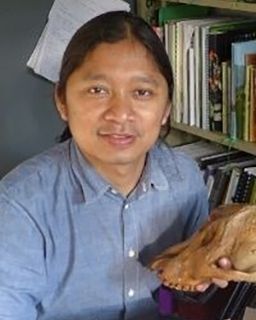Anton Nurcahyo
I would really love to keep working together with the ANU in any way as a person and as part of my NGO.
The Bukit Barisan Selatan National Park, located in South Sumatra of Indonesia, is home to three of the world's most endangered species including the Sumatran tiger. Tourists to the forest region post photos of themselves next to the world's largest flower, the Rafflesia arnoldii – also known as the corpse lily.
It was here where Anton Nurcahyo did his undergraduate research, at a research station in the middle of the national park.
“We were living in the research station with other students and biologists, and would discuss lots of things about our future,” Anton says.
One of their immediate dreams was to become students of well-known researchers in their field. As it happened, an ANU PhD student visited the research station and told Anton about a certain world-leading biological anthropologist and taxonomist at his institution.
Some years passed. Anton successfully applied for a scholarship to Australia and got his chance to study a Master of Biological Anthropology at ANU under Emeritus Professor Colin Groves (who passed away in 2017).
“My reason for going to the ANU was him, one of the gods in my field,” Anton says.
The late Emeritus Professor was also the reason for Anton returning to the ANU to do his PhD on orangutan conservation, the area he worked in after he completed his Masters degree.
“I wanted to identify practical approaches for re-introducing orangutans back to the wild, in particular addressing the issue of returning them into the historical distribution range for each subspecies,” he says. “All Bornean orangutans are one species consisting of three subspecies.”
While undertaking his PhD, Anton wound up helping to discover a new species of orangutan.
It all started for Anton when he attended a symposium on primates in Ha Noi, in Vietnam, in 2014. There was a presentation on orangutan genetics that discussed a group of orangutans in North Sumatra that were genetically significantly different from Sumatran and Bornean orangutans. In collaboration with colleagues who were working on the genetics and ecology of the orangutan, Anton conducted a morphological study. The team established that these orangutans were indeed a different species.
“We believe the population of these orangutans is no more than 800," he says. “They live in a very limited area of around 100,000 square hectares.”
“We need to protect the small amount of habitat these orangutans have left.”
In between making this groundbreaking discovery and chipping away at his PhD, Anton was working hard to make ends meet.
“I was working as a cleaner in the early morning,” Anton says. He'd put in a day's work at the office doing research, go home for dinner with his young family, then head back out to work as a night kitchenhand.
“We were having a tough but very good life,” he says.
“During the weekend though we usually wandered around Belconnen after my boy did his swimming course every Saturday morning. We loved going to the public library from Woden to Gungahlin, enjoyed the museums in Canberra, events like Floriade and Enlighten.”
“I wanted to spend more time with my family,” he adds. “This means when I was in the office, I tried to be productive. I did not join any boot camp for writing my thesis, and I stopped opening social media such as Facebook for more than two years.”
His PhD behind him, Anton is back in Indonesia and currently the Deputy CEO of the non-government organisation Borneo Orangutan Survival. According to Anton, it's the largest NGO in the world in ape conservation, with more than 400 staff who run their programs.
“We help the government of Indonesia manage and rehabilitate forest of more than 400,000 hectares across two provinces,” he says. “We have more than 450 orangutans in our two rehabilitation centres, and more than 70 sun bears.”
In the last seven years, they've released more than 430 orangutans back into the wild.
“Having sites for releasing the orangutans was one of our biggest challenges. We were unable to release orangutans for a decade because there was no designated forest for releasing them.”
This second graduation for Anton marks a total of seven years spent at the ANU. And he's keen to stay connected to the ANU in any way possible – including taking on volunteers at his NGO.
“I would really love to keep working together with the ANU in any way as a person and as part of my NGO,” he says.
Anton's experiences bear out the University's reputation as one of the leading universities in the world: “It has strong resources, from experts and the environment to study, that support students to be people who can make a difference to their community.”
The University also fulfilled Anton's desire to broaden his networks.
“ANU gave me what I wanted,” he says. “I networked with lots of experts in my field and related fields from all over the world.”
“It is one of the biggest advantages in supporting my career and helping me become the person I wanted to be.”
Anton also pays tribute to the late Emeritus Professor Colin Groves, to whom he says he owes a lot.
“He played a significant role in shaping who I am today."

Degree
Learn more about Anton Nurcahyo 's degree: